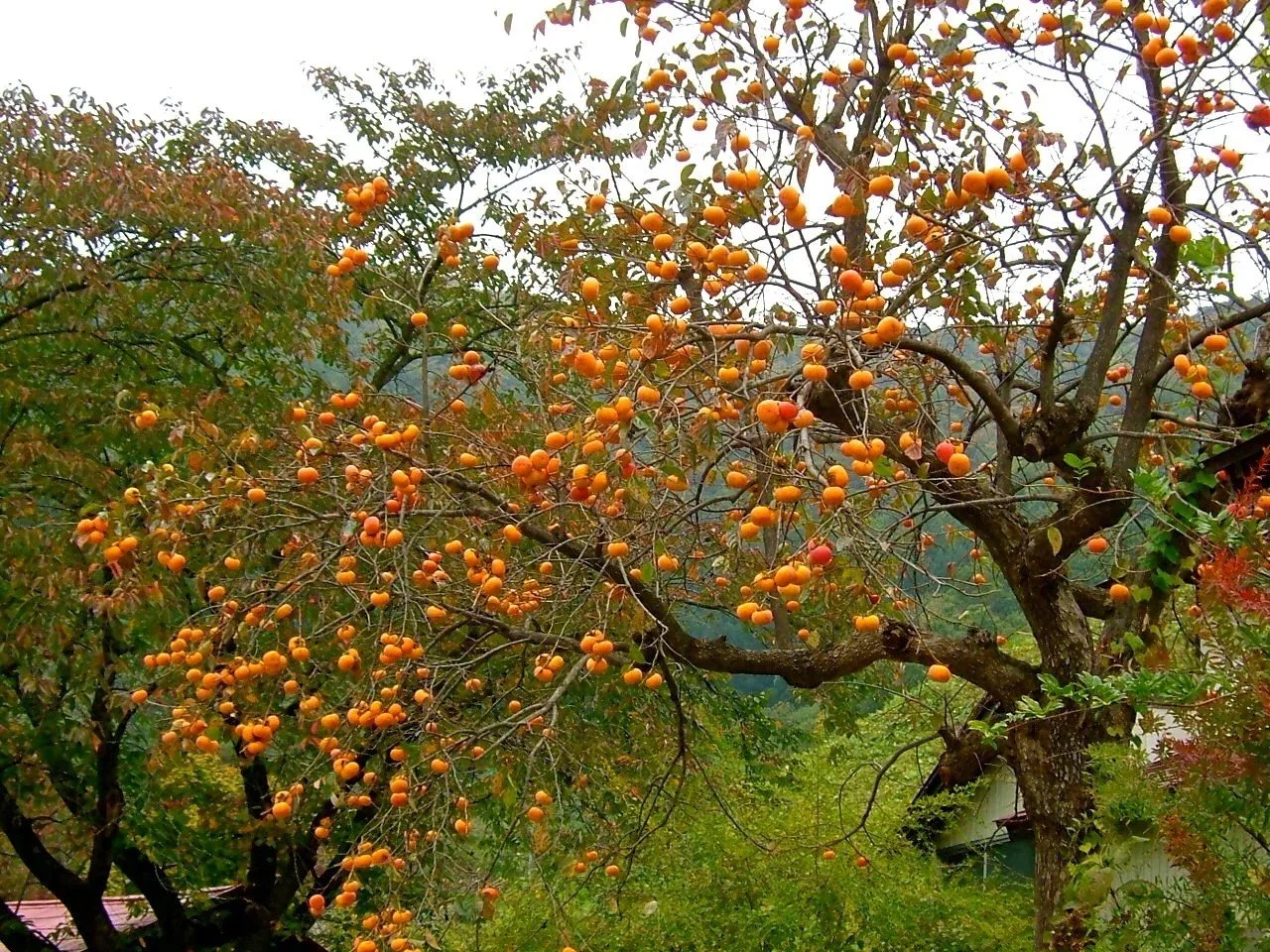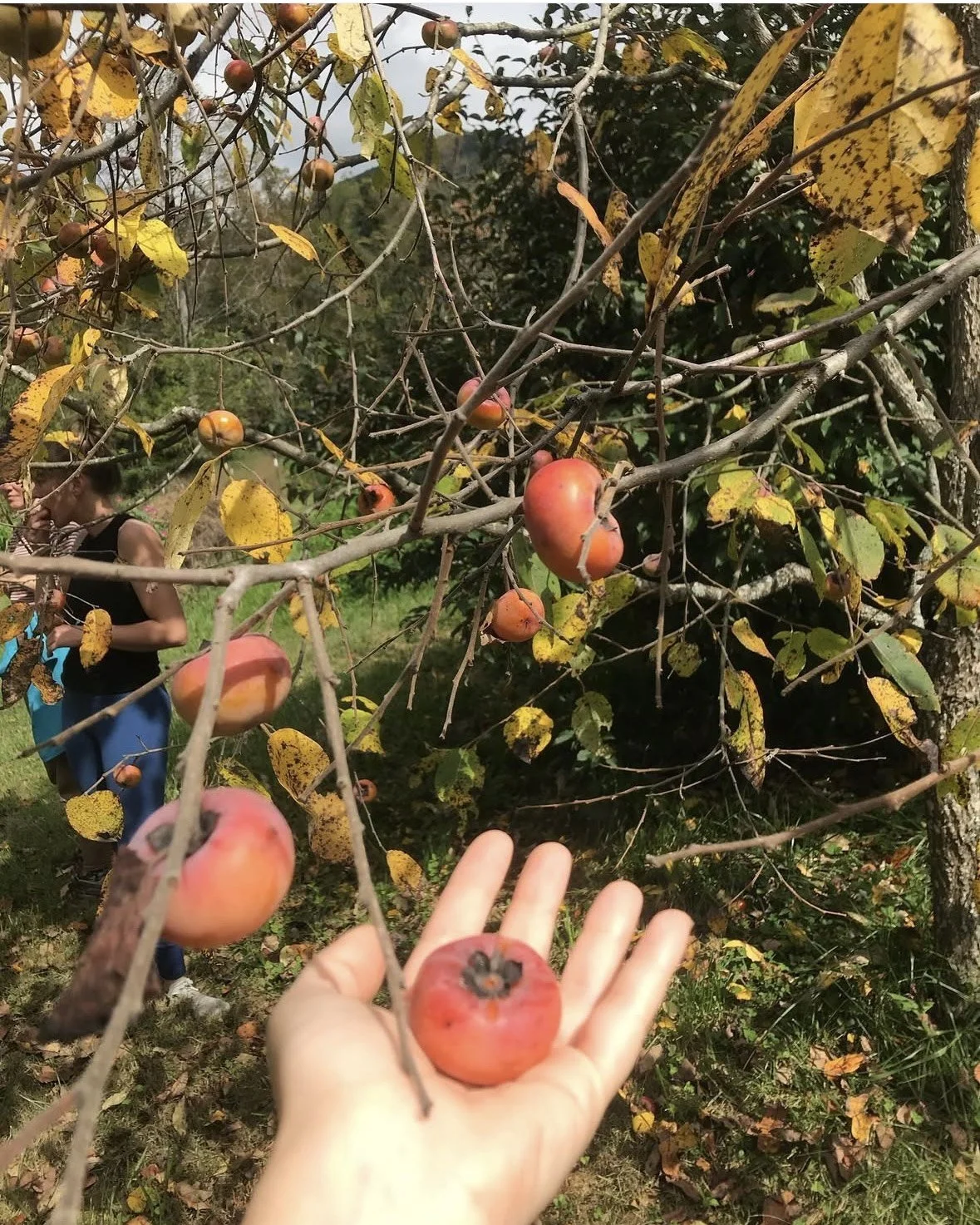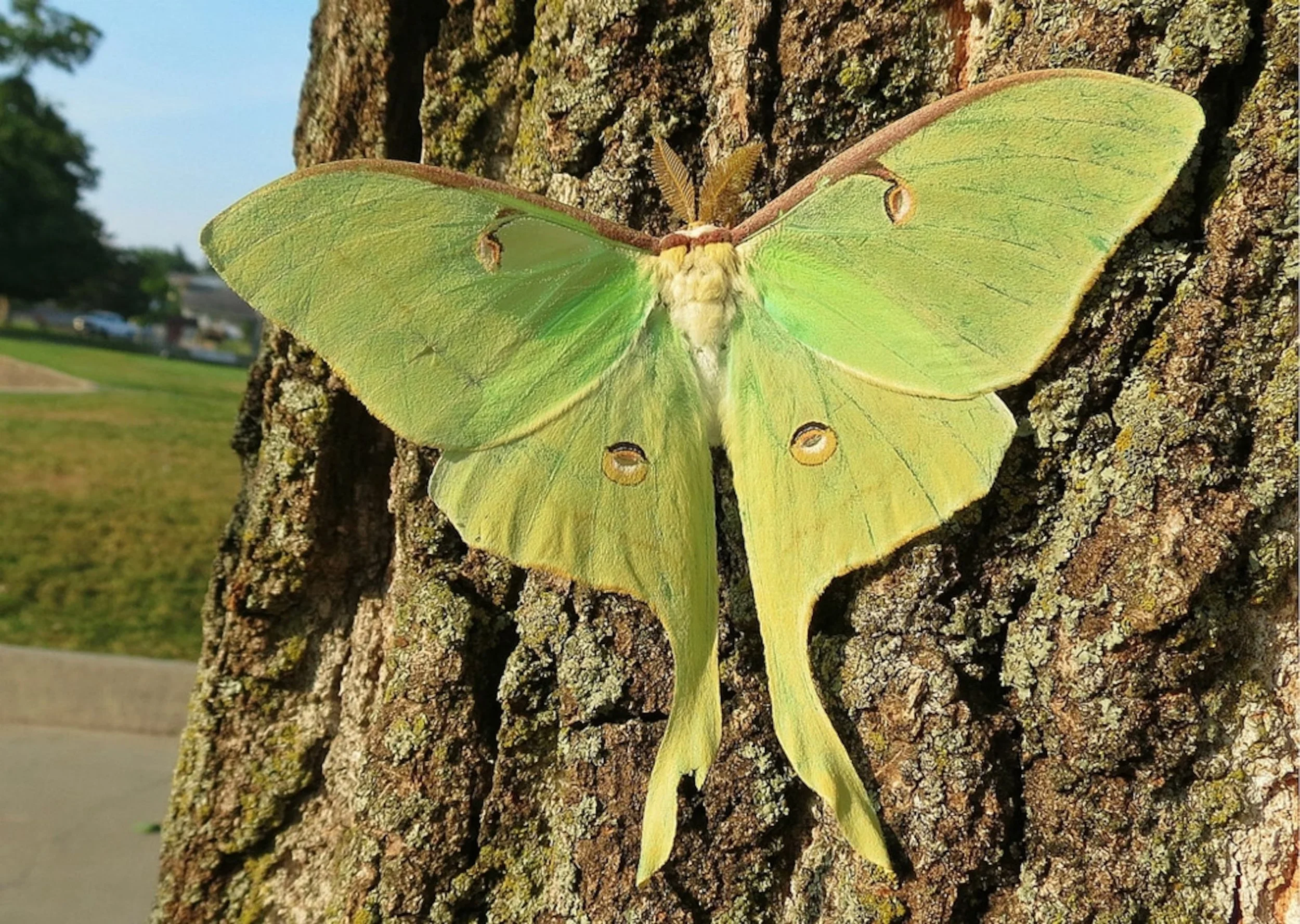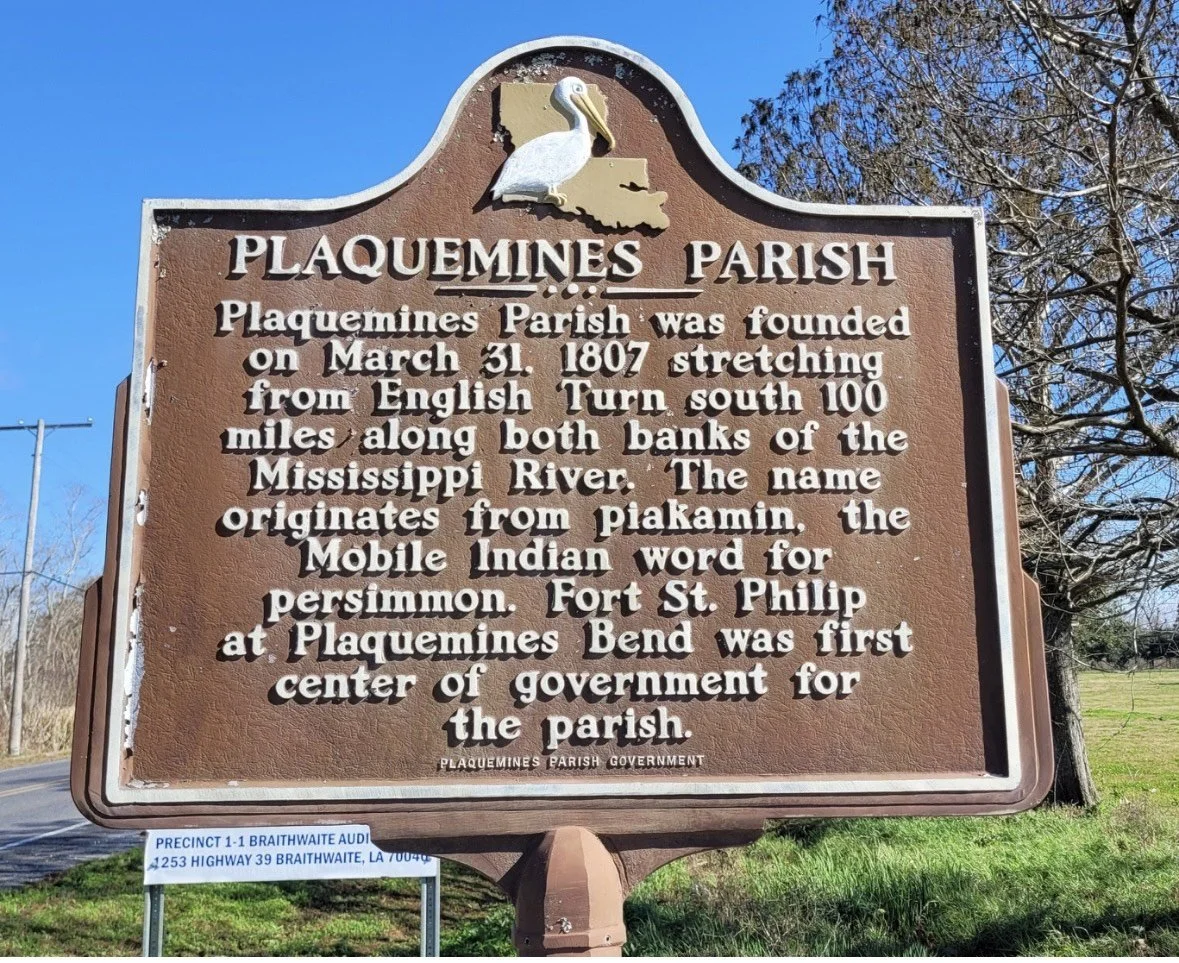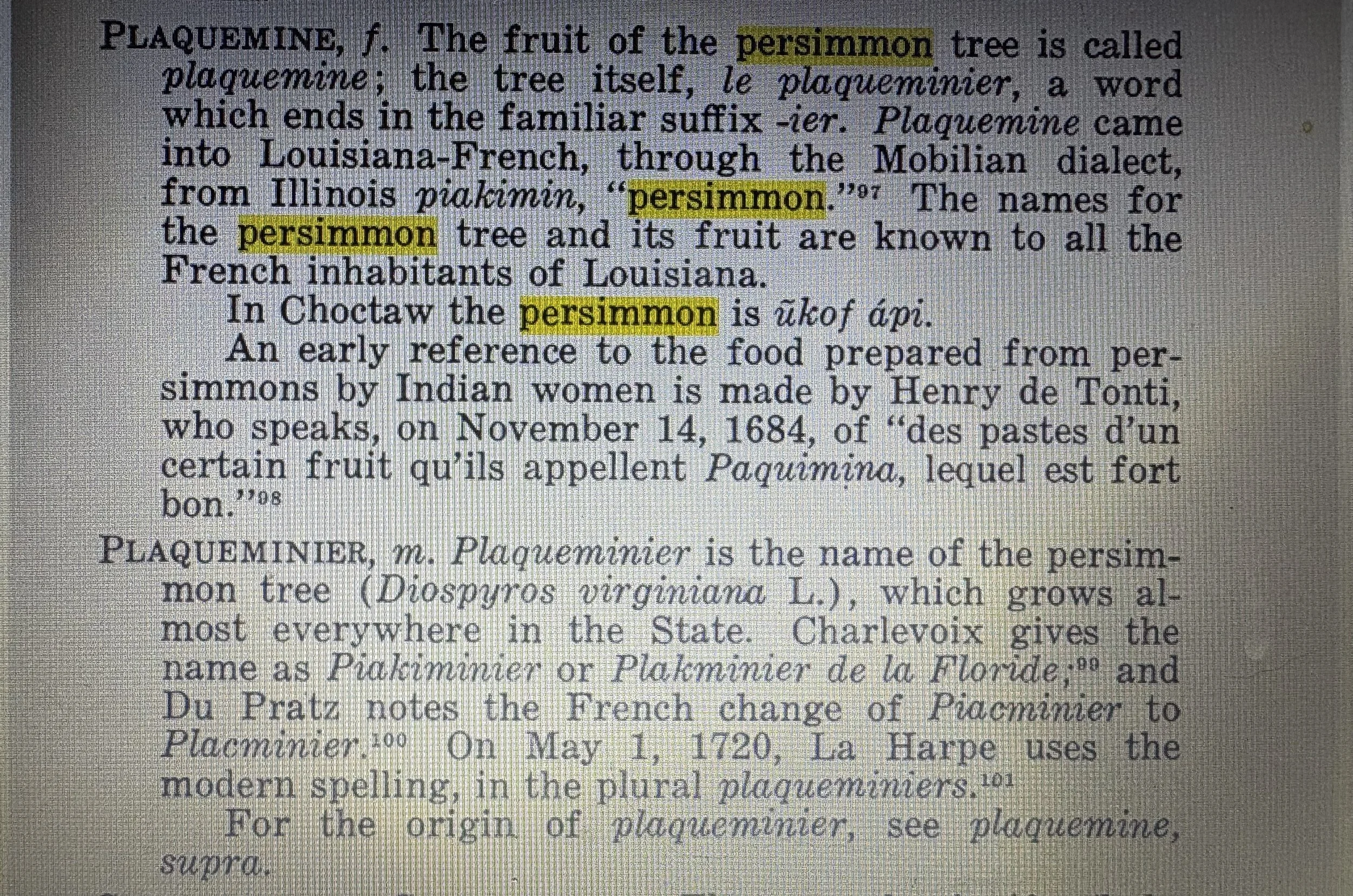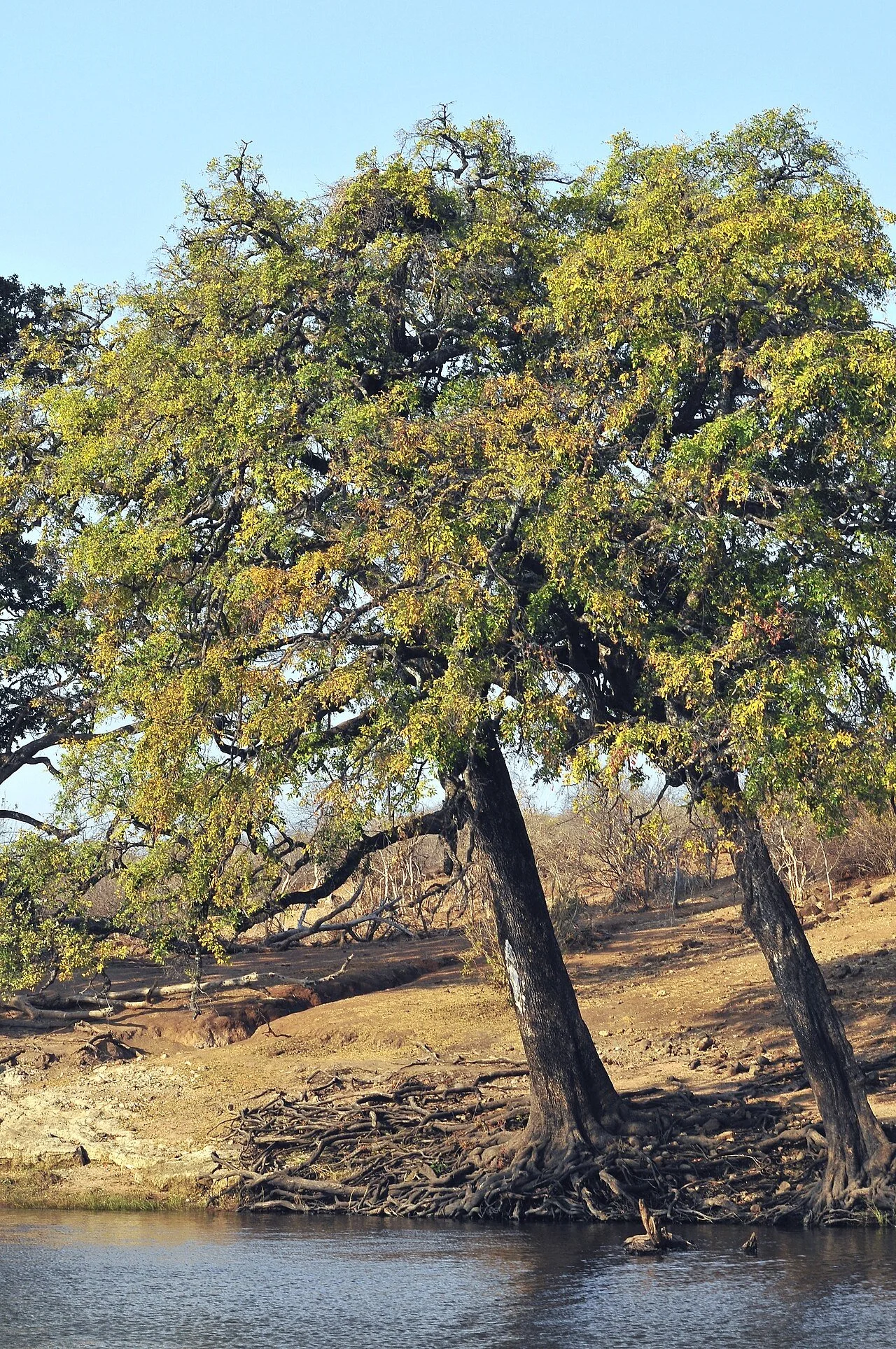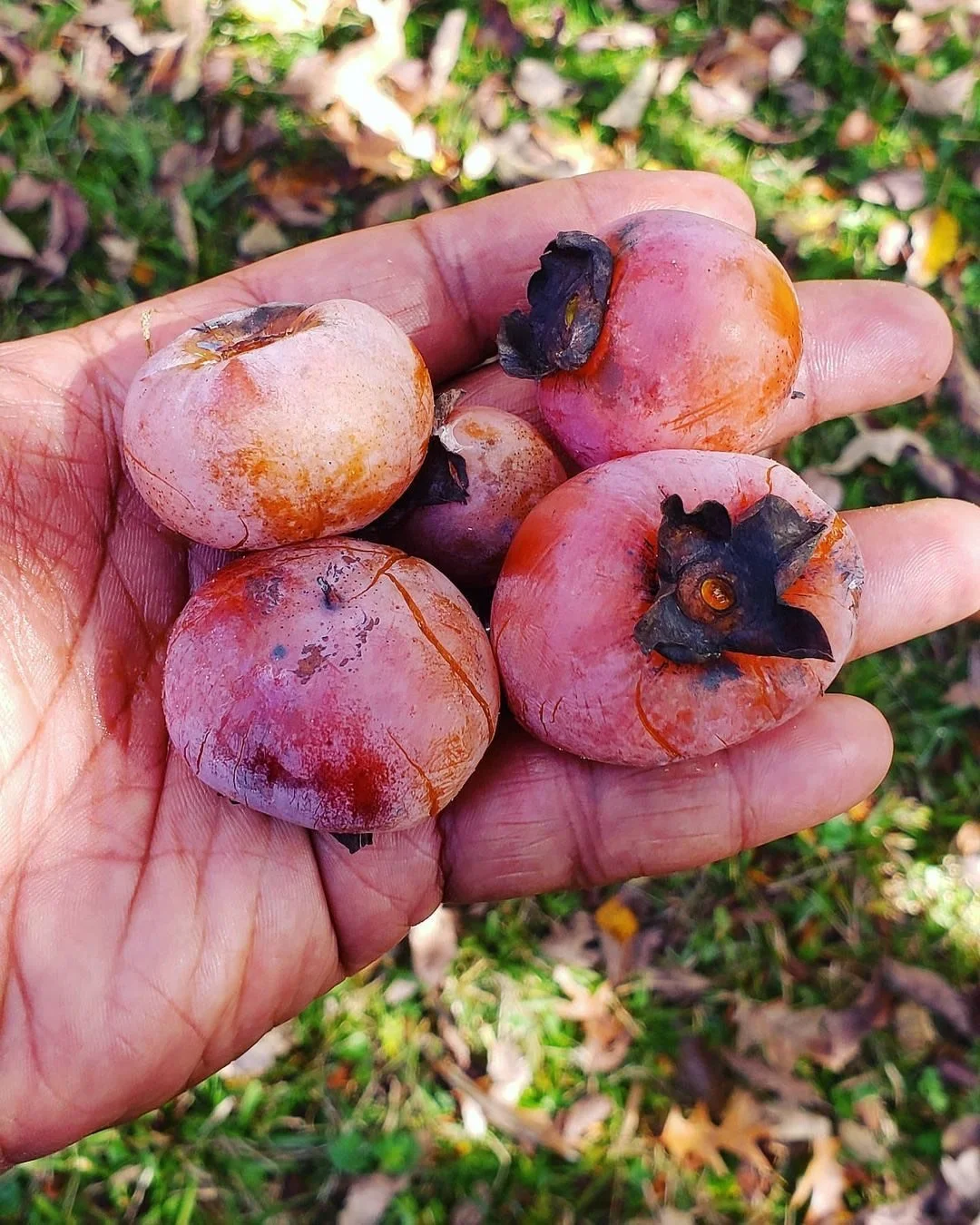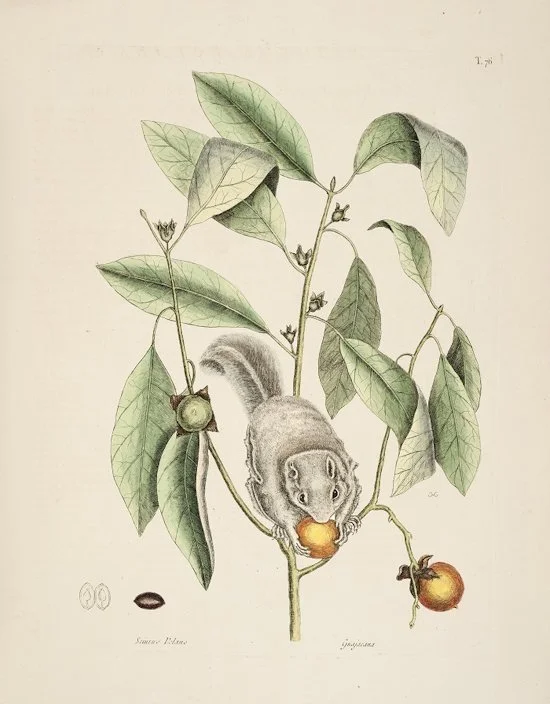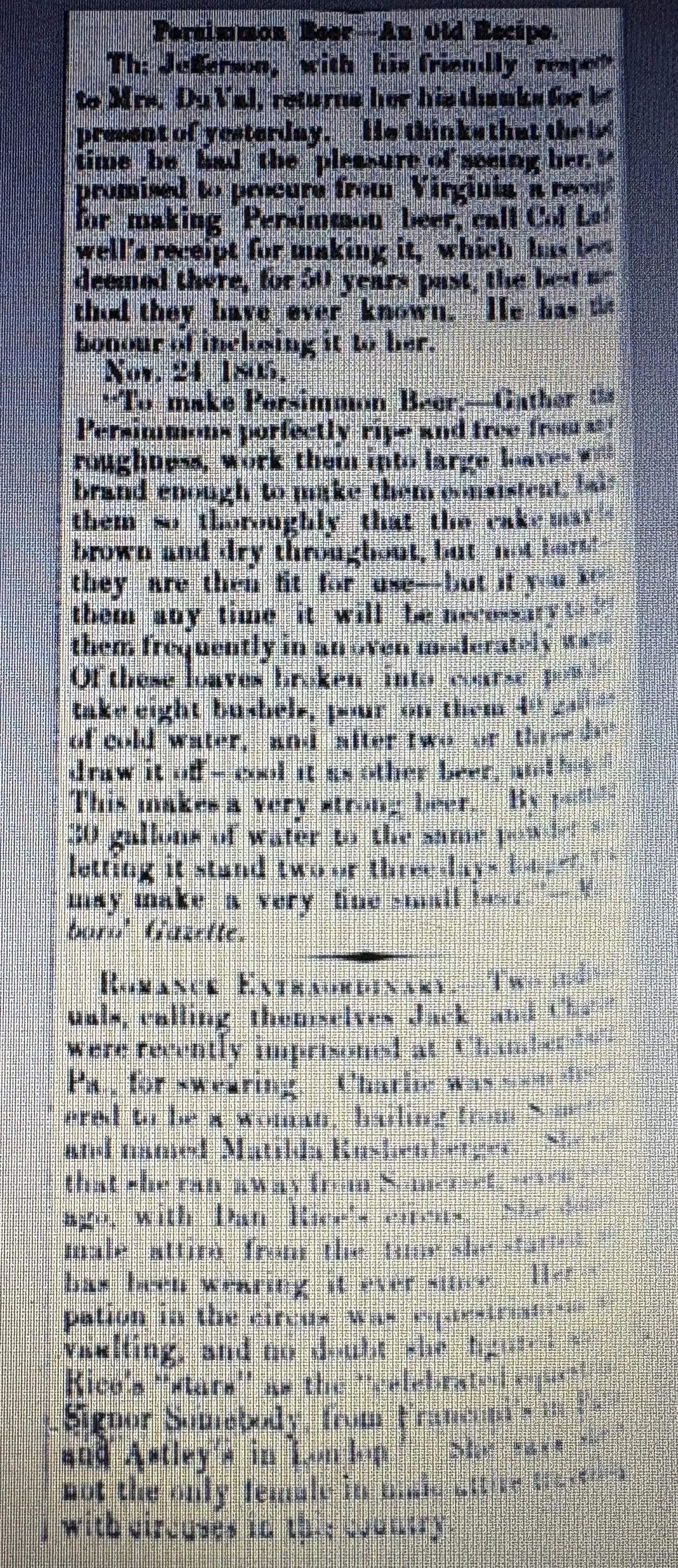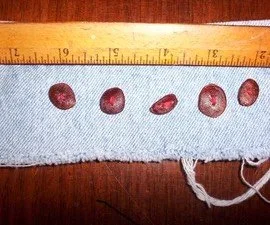American Persimmon
Written by Carmin Nezat
Persimmon! Diospyros virginiana.
Also called Eastern Persimmon, Possumwood, Date Plum, Winter Plum, Possum apples, Sugar plum and Jove's Fruit. Native to central and Eastern USA.
American persimmon been found growing from Connecticut to Florida, and as far as Kansas and Texas. Persimmon grows best in moist, well-drained, sandy soils in full sun to partial shade. It will tolerate hot, dry conditions, poor soils, urban conditions, and wind. These trees are quite slow to produce fruit, sometimes taking up to 10 years from being grown from seed or grafting. Persimmons are dioecious, meaning there are separate male and female trees, and you need both to get fruit! It flowers in the spring and early summer time and produces fruit in early fall.
Native and honey bees are the main pollinators. Persimmon trees are a host plant for the caterpillars of several moth species, including luna moths and royal walnut moths, which eat the foliage. The fruits are of course a favorite to lots of mammals and both song and wild game birds. But that being said, cattle and horses especially should not have access to them! These animals did not evolve with persimmons. The skin of the fruit can contribute to a buildup of an indigestible mass in their gastrointestinal tract, called a “bezoar.” It can lead to serious complications, and the tannins of the fruit can induce colic!
Luna moth aka Actius luna
The name persimmon comes from 'putchamin,' a phonetic rendering of the name used by the Algonquin tribe (historically Ottowa River valley area) of the American Indians. Powhatans called it “putchamin;” others, “pessamin” or “pasiminian.” The word Plakemine is a Chitimacha word for persimmon. The town of Plaquemine, Louisiana was originally inhabited by the Chitimacha people and were living there when Pierre LeMoyne, Sieur de Iberville arrived in 1699 and claimed all of Louisiana for King Louis XIV of France. Although according to Flore Louisiane, “the name plaquemine came into Louisiana French through the Mobilian dialect from the Illinois Indian ‘piakimin,’ meaning persimmon.” But then on the Plaquemines Parish marker sign, it states “piakimin” is the Mobile Indian name. “One scientist writing in 1896 said the Native American name translates to ‘choke fruit’—biting into a persimmon before it ripens in the fall will turn your mouth inside out.”
Traditional Cajun usage is as a gargle made with the buds for sore throat. The persimmon tree is referred to as “plaqueminier”, and the fruit called “plaquemine.”
Louisiana French Dictionary
Historical documents referencing African American healing practices note that persimmon (raw fruit) was used as a vermifuge (anti-parasitic/de-wormer) in the early Antebellum time period (1600-1820) and for thrush and teething in the Contemporary (1970-present) time period. Persimmon was likely used during the Late Antebellum (1821-1864) and Post-Bellum (1865-1969) time periods as well, although there is no documentation stating its applications. As far as the enslaved and emancipated African Americans uses of persimmon, its hard to say exactly when the medicinal application changed from anti-parasitic to thrush/teething, but it is documented that many Native Americans found the persimmon to be particularly functional for the treatment of pain and oral sores- and many medicinal plants were appropriated by other groups throughout history- obviously!! And as far as the early Antebellum enslaved, it is likely they already knew how to use it due to their familiarity with the African Disospyrus mespiliformis which was prized for its medicinal value and used to treat diarrhea, dysentery, diphtheria, hemorrhoids and sexually transmitted diseases.
Disospyrus mespiliformis
An INCREDIBLY informative article by Lee Graves, titled Persimmon Beer: From African Roots to Southern Icon, suggests that “Diospyros virginiana would have reminded them (the enslaved West Africans) of their own Diospyros mespiliformis, the African persimmon from what is commonly called the jackalberry tree. Its fruit, known as “alom” to the Wolof and “kuku” to the Fula peoples, was used for medicinal purposes, as a food source used in bread and to make beer.”
Ripe and overripe fruits of Diospyros mespiliformis
From Lee Graves’ same article comes this quote from a Mr. Nick Waller who was interviewed for the Federal Writers’ Project (USA) in the 1930’s: “That old persimmon beer was half of our living; Us chillun would gather persimmons by the bucketfulls. Mother would cook ’em with wheat bran and make it out into the big pones that she used to make the beer mash and she put lots of [honey] locusts in it. That beer was really good and so refreshin’ after a hard day’s work.”
Keep reading to hear about the fascinating persimmon beer- and the idea that it was likely a combination of the enslaved and the European settlers “who brought the fermentation of Native American fruits into Southern culture!”
The Cherokee used a syrup (unspecified part of the plant) for sore throat (”astringent plant used for sore throat and mouth”), thrush, bloody discharge from bowels; compound infusion for toothache; cold infusion of bark taken for bile and liver; compound used in steam bath for indigestion or biliousness; used as a wash for piles; used for venereal disease (unspecified); and used as a food and to make pudding. The Seminole also used the plant as a food. The Rappahanock (Virginia) used an infusion of inner bark as a wash for thrush, and an infusion of “north side” bark for sore throat. They also made a persimmon beer by rolling the fruits in corn meal, boiling, baking and adding water. BUT according to a Dr. Julie Markin, associate professor of anthropology at Washington College, “A ‘beer’ in this instance is likely to be of the root or ginger beer variety and not an alcoholic beverage.” AND THIS IS BECAUSE (according to historians) alcoholic beverages were not a part of Native American culture in the Southeast BEFORE the arrival of European colonizers!
Persimmon beer, like the actual fermented beverage, LIKELY wasn’t a thing in the New World until after European contact. “The enslaved, Native Americans and indentured servants rubbed shoulders often in work settings, and a bit of Powhatan persimmon bread or cake could easily have been appropriated for brewing along with corn or honey locust pods (frequently mentioned in colonial recipes). The first mention of persimmon beer in English by Robert Beverley in 1705 describes using dried cakes of the fruit for brewing. Beverley also ascribes persimmon beer—along with beer made from molasses, potatoes, Indian corn and just about any other source of fermentable sugars—as being made ‘among the poorer sort,’ i.e. indentured servants, slaves and Native Americans.” But persimmon beer was likely more a cider.
Thomas Jefferson’s persimmon beer recipe!
Other medicinal applications? The unripe fruit is high in tannic acid which gives it its astringent property and ability to treat diarrhea, dysentery, and heavy uterine bleeding. A decoction of the inner bark has similar effects due to its high tannic concentration. In Healing Traditions of South Louisiana, there’s a notable paragraph pertaining to persimmons’ medicinal importance within Samuel Touchstone’s book Herbal and Folk Medicine of the South; “During the late 1920’s, there was a severe outbreak of bloody flux among infants and young children. Nearly all the affected children treated by a doctor died. But the backwoods folks knew to make a decoction of persimmon bark and added water to make tea, which they administered to their children day and night. None of their infants died.”
Other notable uses: A tea can be made from the dried leaves that are high in vitamin C and have a pleasant flavor somewhat like sassafras. The roasted seed can be used as a coffee substitute (or more like a coffee extender). The seeds have historically been used as clothing buttons during the American Civil War when standard buttons were scarce due to the Union Blockade. The boiled unripe persimmons could be used for ink.
persimmon seed buttons
In American folklore, the shape of the kernel inside the persimmon seed is said to forecast the upcoming winter. A spoon shape predicts a snowy winter, a fork shape for mild winter, and a knife shape for a sharp, harsh winter. But for the prediction to be accurate, it must be a locally grown tree.
Persimmon seeds telling the future
usgulfcoaststatesgeotourism.com/content/a-bayou-runs-through-it-plaquemine-la/gulC342F128ED911209C
Plaquemine History | Plaquemine, LA
Healers-Garden-Brochure-Web.pdf (vermilionville.org) persimmon
Hamel, Paul B. and Mary U. Chiltoskey, 1975, Cherokee Plants and Their Uses -- A 400 Year History, Sylva, N.C. Herald Publishing Co., page 49. BRIT - Native American Ethnobotany Database Diospyros virginiana
https://plants.ces.ncsu.edu/plants/diospyros-virginiana/
Perry, Myra Jean, 1975, Food Use of 'Wild' Plants by Cherokee Indians, The University of Tennessee, M.S. Thesis, page 38. BRIT - Native American Ethnobotany Database Diospyros virginiana
Sturtevant, William, 1954, The Mikasuki Seminole: Medical Beliefs and Practices, Yale University, PhD Thesis, page 495. BRIT - Native American Ethnobotany Database Diospyros virginiana
Briand.indd (salisbury.edu)
Hamby, Erin Brooke, "The Roots of Healing: Archaeological and Historical Investigations of African American Herbal Medicine. " PhD diss., University of Tennessee, 2004. https://trace.tennessee.edu/utk_graddiss/4543 p163
Speck, Frank G., R.B. Hassrick and E.S. Carpenter, 1942, Rappahannock Herbals, Folk-Lore and Science of Cures, Proceedings of the Delaware County Institute of Science 10:7-55., page 25
https://www.backyardecology.net/american-persimmon/
Persimmon Beer: From African Roots to Southern Icon | leegraves.com
Perrin, Mary Broussard and Beverly Constantine Fuselier. Healing Traditions of South Louisiana: Prayers, Plants and Poultices. Andrepont Publishing. Opelousas, La. 2022. P 113.
file:///C:/Users/me280/Downloads/Read-Louisiana-French.pdf p 103

